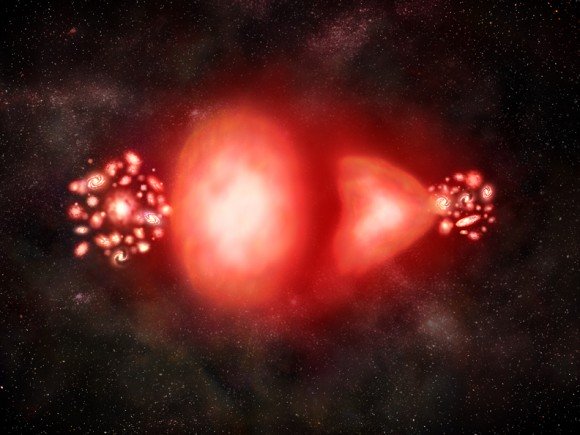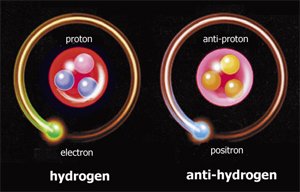|
ALPHA Closes in on Antimatter
by AMY
SHIRA TEITEL on MARCH
10, 2012

What matter and antimatter might look like
annihilating one another. Credit: NASA/CXC/M. Weiss
We live in a universe made of matter. But at the
moment of the Big Bang, matter and antimatter existed in equal
amounts. That antimatter has all but disappeared suggests that
nature, for some reason, has a strong preference for matter.
Physicists want to know why matter has replaced its antimatter
twin, and this week the ALPHA collaboration at CERN got a step
closer to unraveling the mystery.
ALPHA, an international collaborative experiment
established in 2005, was designed to trap and measure
antihydrogen particles with a specially designed experiment.
It’s picking up where its antimatter-searching predecessor,
ATHENA, left off. The focus is on antihydrogen because hydrogen
is the most prevalent element in the universe and its structure
is extremely well known to scientists.
Each hydrogen atom has one electron orbiting its
nucleus. Firing light at the atoms excites the electron, causing
it to jump into an orbit further away from the nucleus before it
relaxes and returns to its resting orbit emitting light in the
process. The frequency distribution of this emitted light is
known; it has been precisely measured and, in our universe made
of matter, is unique to hydrogen.

An illustration of
hydrogen and antihydrogen. Credit: USAF
Basic physics dictates that hydrogen’s antimatter
twin, antihydrogen, should be equally recognizable by having an
identical spectrum. That is, if everything we know about
particle physics is right. Capturing and measuring
antihydrogen’s spectrum is the main goal of the ALPHA group.
ALPHA has taken the first modest measurements of
antihydrogen. In the ALPHA apparatus, antihydrogen is trapped by
an arrangement of magnets that
affect the magnetic field of the atoms. Microwaves tuned to a
specific frequency aimed on these antihydrogen atoms flips their
magnetic orientation, liberating them. The freed antihydrogen
meets hydrogen as it escapes and the two annihilate one another,
leaving a well known pattern in particle detectors surrounding
the apparatus.
The apparatus captured evidence of the electron
jumping orbits in an antihydrogen atom after microwave radiation
changed its internal state. The result further proves the
validity of ALPHA’s approach, demonstrating that the apparatus
has enough control and sensitivity to successfully carry out the
experiment it was designed for. In the future, ALPHA will focus
on improving the precision of its microwave measurements to
uncover the antihydrogen spectrum using lasers.
The exciting results were hard to come by as
antihydrogen does not exist in nature. It’s made in the ALPHA
apparatus from antiprotons that are themselves made in the
Antiproton Decelerator and positrons from a radioactive source.
And it has to have a low enough energy level to stay trapped for
measurements. But it’s working, and it just might give
physicists the key they need to understand the mystery of the
early universe.
Source: CERN
1 2 3 4 5 6 7 8 9 10 Newest
articles
|


